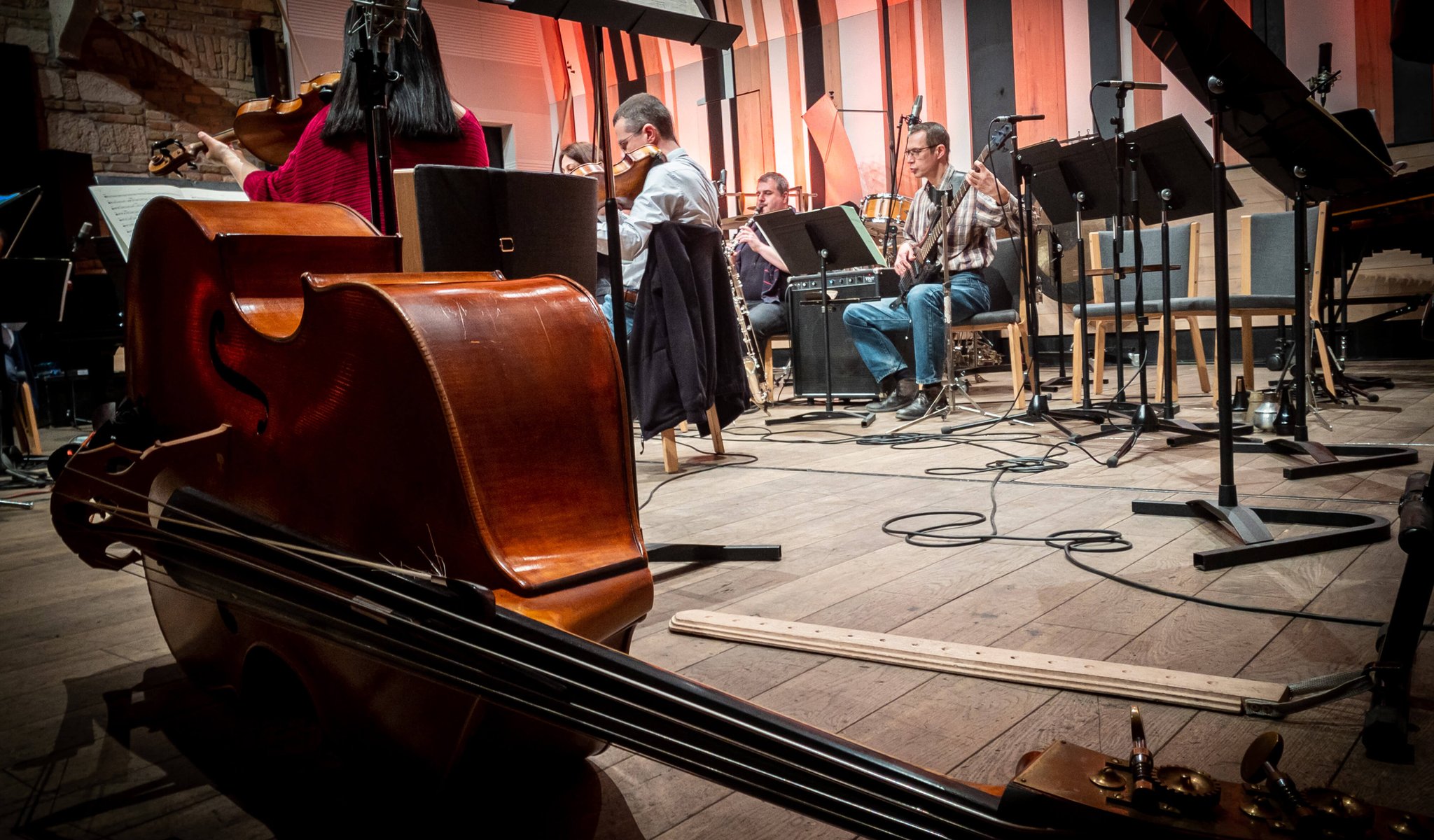
Takemitsu, Tower, Gubajdulina, Ligeti, Cage, Connesson
Program
Tōru Takemitsu (→ bio)
Rain Spell
Anett Jóföldi (flute), Roland Csalló (clarinet), Ágnes Polónyi (harp), István Kurcsák (percussion), Emese Mali (piano)
Joan Tower
Copperwave
Gergely Csikota, Tamás Póti (trumpet), András Szabó (horn), Attila Sztán (trombone), József Bazsinka (tuba)
Sofia Gubaidulina
Meditation on a Bach Chorale, “Vor deinen Thron tret’ ich hiermit” (BWV 668)
István Kádár, Csaba Czenke (violin), Barna Juhász (viola), Rita Sovány (cello), Attila Martos (double bass), Emese Mali (piano)
INTERVAL
John Cage
Living Room Music
István Kurcsák, László Herboly, Boglárka Fábry, Gábor Pusztai (percussions)
György Ligeti (→ bio)
Six Bagatelles
Anett Jóföldi (flute), Beáta Berta (oboe), Roland Csalló (clarinet), Dániel Tallián (bassoon), Dávid Bereczky (horn)
Guillaume Connesson
Sextet
Beáta Berta (oboe), Roland Csalló (clarinet), István Kádár (violin), Barna Juhász (viola), Attila Martos (double bass), Emese Mali (piano)
Other information
The event is about 2.5 hours long.
About the event
Six composers, six pieces, sixty-six years, but nothing diabolical. In fact, several aspects of the season’s only performance to be hosted at the BMC will direct the audience’s gaze skywards towards the heavens. We may rightfully label the evening a contemporary concert, although only one of the pieces on the program, featuring works composed between 1940 and 2006, was written after the turn of the millennium. The BFO’s musicians will present composers, both legendary and lesser-known, who stood up to resistance encountered in their time, stuck to their innovative visions and produced oeuvres which have found their ways to the hearts not only of other professionals, but also audiences. The works incorporate a diverse range of formations, unique sounds and exciting back stories, with themes covering rain, copper, Bach, economizing on musical notes, essentially “anything” and the new year.
Water is one of the key motifs in the art of Japanese Tōru Takemitsu, as he interprets the water cycle of the world as a fluid process. Rain Spell, which employs fluid and mysterious music, places the colorful and magical phenomenon of rain at its center, with the help of the sounds and silences of the flute, the clarinet, the harp, the piano and the vibraphone.
“My father was a geologist and mining engineer,” Joan Tower has said, describing her attraction to minerals and stones. She has composed music about topaz and silver; and her 2006 piece, Copperwave, spotlights heavy, soft copper – naturally enough, on the brass winds. The Latin motifs of the piece evoke the years Tower spent in Bolivia as a child.
Mentored by Shostakovich and blacklisted by the Soviet Union, she was even more driven to be liberated through her art. Sofia Gubaidulina drew inspiration from so many quarters; her main role model was nonetheless Bach. It was shortly before he passed away that Bach worked on the slow choral theme which appears in Gubaidulina’s work, representing the Baroque master’s ascent to heaven using string instruments and the harpsichord.
John Cage was able to turn literally anything into music. His piece Living Room Music, for four performers, was intended to be performed using any household object, and can thus be played even in the living room. The polyrhythmic first movement is followed by a prose part for the phrase, “once upon a time;” then, after a melodious movement, downright pleasant rhythms serve as the ending.
Of the twelve bagatelles he composed earlier for the piano, Ligeti arranged six for a wind quintet in 1953. The movements exude “imaginary folklore” and “limping folk music.” The short, succinct bagatelles, using only few notes, feature dissonant, cool, moving, wild and passionate music, and even funeral music paying tribute to Bartók.
Paris was home to a special New Year’s concert on January 4, 1998, featuring Guillaume Connesson’s sextet in three movements, a truly entertaining and humorous piece. Following the variation movement Dynamique, evoking American repetitive music, a calm nighttime part (Nocturne) follows, featuring a clarinet solo; the piece concludes with a festival atmosphere including fireworks.
Did you know? Takemitsu’s piece premiered on January 19, 1983 in Yokohama; Tower’s Copperwave premiered in New York on May 4, 2006; Gubaidulina’s Meditation was first performed on August 25, 1994 in Tokyo; Ligeti’s Six Bagatelles was composed in 1953 (with the premiere taking place on October 6, 1969 in Södertälje); Cage wrote his Living Room Music in 1940; Connesson’s Sextet premiered in Paris on January 4, 1998; the Budapest Festival Orchestra most recently performed Ligeti’s Six Bagatelles on October 16, 2023 in Rome; this will be the BFO’s first performance of the other pieces.
Contemporary events: Polish composer Witold Lutosławski’s Symphony No. 3 premiered in Chicago on September 29, 1983 / Canadian author Alice Munro’s collection of stories The View from Castle Rock was published in 2006; the author would later be awarded the Nobel Prize / On April 1, 1994, Hungary submitted its request to join the European Union / American author John Updike’s novel Brazil was published in 1994 / Dutch graphic artist Maurits Cornelis Escher produced his lithograph Relativity in 1953 / Austrian composer Arnold Schönberg’s Violin Concerto premiered in Philadelphia on December 6, 1940 / As part of preparations for Operation Seelöwe (“Sealion”), the German air force began the systematic bombing of England on August 1, 1940 / Spanish painter Salvador Dalí painted his depiction The Face of War in 1940 / English author J. K. Rowling published her novel Harry Potter and the Philosopher’s Stone in 1998